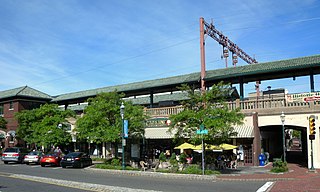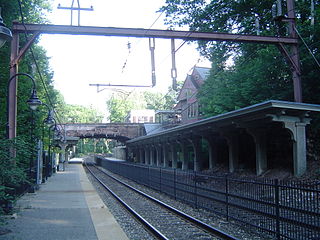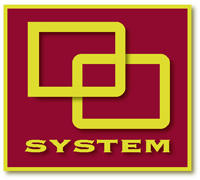
The Delaware, Lackawanna and Western Railroad, also known as the DL&W or Lackawanna Railroad, was a U.S. Class 1 railroad that connected Buffalo, New York, and Hoboken, New Jersey, and by ferry with New York City, a distance of 395 miles (636 km). Incorporated in Pennsylvania in 1853 primarily for the purpose of providing a connection between the anthracite coal fields of Pennsylvania's Coal Region and the large markets for coal in New York City. The railroad gradually expanded both East and West, eventually linking Buffalo with New York City.

The New York, Susquehanna and Western Railway is a Class II American freight railway operating over 400 miles (645 km) of track in the northeastern U.S. states of New York, Pennsylvania, and New Jersey.
The New Jersey West Line Railroad was a proposed railroad running east and west across Northern New Jersey, of which the only part constructed was what is now the Gladstone Branch of New Jersey Transit between Summit and Bernardsville. Some other remains of it can be found in Summit, Millburn, and Union Township.

Highland Avenue is an active commuter railroad station in the city of Orange, Essex County, New Jersey. One of two in the city, along with the eponymous Orange station, Highland Avenue is serviced by trains of New Jersey Transit's Morris and Essex Lines: the Morristown Line and Gladstone Branch. Trains through the station run between New York Penn Station and Hoboken Terminal to the east and Hackettstown and Gladstone. The station contains two low-level side platforms for the three tracks that run through the station.

Mountain Station is a New Jersey Transit station in South Orange, Essex County, New Jersey, United States, along the Morris and Essex. The station, built in 1915, was designed by Frank J. Nies. It has been listed in the New Jersey Register of Historic Places and National Register of Historic Places since 1984 and is part of the Operating Passenger Railroad Stations Thematic Resource.

South Orange is a New Jersey Transit station in South Orange, New Jersey along the Morris and Essex rail line. It is located in the business district of South Orange, near its town hall. It is one of two train stations in the township of South Orange, Mountain Station being the other near the township border. South Orange station was built by the Lackawanna Railroad in 1916.

Mount Olive is a NJ Transit station in Mount Olive, New Jersey, located in the International Trade Center. The station, located on the side of Waterloo Village Road, services trains for both the Montclair-Boonton Line and the Morristown Line along trackage owned by Norfolk Southern. The line is not electrified from Hackettstown to Dover, where passengers can transfer to an electric Morristown Line train via Summit or a diesel Montclair-Boonton train via Wayne and Montclair. Trains along both lines head to Hoboken Terminal in Hoboken, New Jersey or New York Penn Station at 34th Street in New York City, although Montclair-Boonton trains require a transfer at Montclair State University or Newark Broad Street for electrified service to New York. It is also the least-used station in the NJ Transit commuter rail network.

Glen Ridge is a New Jersey Transit station at the intersection of Bloomfield Avenue and Ridgewood Avenue in Glen Ridge, Essex County, New Jersey along the Montclair-Boonton Line. Service through Glen Ridge comes from Hoboken Terminal and New York Penn Station and goes through to one of four termini, Bay Street, Montclair State University, Dover and Hackettstown. The station depot is on-grade level with Ridgewood Avenue, with the platform and tracks below street-level.

Lincoln Park is a station on NJ Transit's Montclair-Boonton Line in the borough of Lincoln Park, Morris County, New Jersey. The station is located near the Comly Road overpass, accessible from Main Street, Station Road and Park Avenue.

Roseville Avenue was a transfer station on New Jersey Transit's Morris & Essex Lines in Newark, New Jersey, United States. The station was built by the Delaware, Lackawanna and Western Railroad in 1903 as part of a project to lower the tracks below the road surface to eliminate grade crossings. It serviced Newark's Roseville neighborhood. It once had two tracks on the Lackawanna mainline and two low-wall platforms, with an additional platform along the Montclair Branch. The station remained in service during most of the 20th century, until New Jersey Transit closed the station on September 16, 1984.

The Delaware Otsego Corporation (DO) is an American railway holding company which owns the New York, Susquehanna and Western Railway and the Central New York Railroad. It is headquartered in Cooperstown, New York in Otsego County.

Delawanna is a commuter rail station for New Jersey Transit in the Delawanna section of Clifton, Passaic County, New Jersey. The station, located at the intersection of Delawanna Avenue and Oak Street, serves trains on New Jersey Transit's Main Line, serving Hoboken Terminal on the east end and Suffern and Port Jervis stations on the west end in New York. Delawanna station has two low-level side platforms with a shelter on the inbound side, lacking access for the physically disabled under the Americans With Disabilities Act of 1990.
The Sussex Railroad was a short-line railroad in northwestern New Jersey. It replaced its predecessor, the Sussex Mine Railroad, in 1853 and operated under the Sussex Railroad Company until 1945 when it was fully merged into the Delaware, Lackawanna and Western Railroad (DL&W) system. The Sussex Railroad was important in the economic development of Sussex County as it supplied a route for early local industries, such as dairy farms and ore mines, to export their products. It was the last independently operated New Jersey railroad to be incorporated into the DL&W system. The last train travelled on the Sussex Railroad tracks on October 2, 1966. The tracks were removed soon after and the right-of-way was transformed into a rail trail known as the Sussex Branch Trail.
The Boonton Branch refers to the railroad line in New Jersey that was completed in 1870 and ran 34 miles (54.8 km) from Hoboken to East Dover Junction as part of the Morris & Essex Railroad (M&E). Although the branch hosted commuter trains, the line was primarily built as a freight bypass line. The term "branch", therefore, is somewhat of a misnomer since the Boonton Branch was built to higher mainline standards than the Morristown Line, the line that it bypassed. As a result, the Boonton Branch better meets the definition of a "cut-off" rather than a branch. Some of the towns that the Boonton Branch passed through included Lyndhurst, Passaic, Clifton, Paterson, Wayne, Lincoln Park, Mountain Lakes, and its namesake, Boonton.

Phoebe Snow was a named passenger train which was once operated by the Delaware, Lackawanna and Western Railroad (DL&W) and, after a brief hiatus, the Erie Lackawanna Railway (EL).

Port Morris Junction is the railroad connection between NJ Transit's Montclair-Boonton Line and the Lackawanna Cut-Off. Opened in 1911 by the Lackawanna Railroad, it is in the Port Morris, New Jersey section of Roxbury Township, New Jersey, south of Lake Hopatcong.

The Nicholson Cutoff is a railroad segment of the Sunbury Line rail line and formerly a railroad segment of the Delaware, Lackawanna and Western Railroad main line and the Delaware and Hudson Railway South Line. The Nicholson Cutoff and the rest of the Sunbury Line is owned by Norfolk Southern Railway.
The Elmira, Cortland and Northern Railroad was a railroad in the state of New York, in the United States. Its main line ran from Elmira, New York, to Camden, New York. It was formed in 1884 from the consolidation of other railroads and merged into the Lehigh Valley Railroad in 1905. Under the Lehigh Valley, it was known as the Elmira and Cortland Branch. Almost all of its former line has since been abandoned.
The Southern Central Railroad is a defunct railroad which operated in the state of New York in the nineteenth century. The company's line ran from Fair Haven, New York, on the south shore of Lake Ontario, to Athens, Pennsylvania, in the Southern Tier and just over the border into Pennsylvania. The company was incorporated in 1865 and became part of the Lehigh Valley Railroad system in 1895. Most of its line was abandoned by the Lehigh Valley Railroad between 1937–1979; the portion between Harford Mills, New York, and Owego, New York, is owned by the Tioga County Industrial Development Agency and operated by the Owego and Harford Railway.















